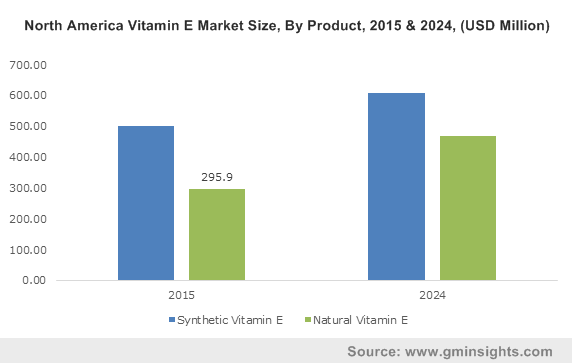Vitamin E market to witness highest growth from cosmetic application, U.S. to majorly drive the global landscape
Publisher : Fractovia | Published Date : 2017-05-31Request Sample
Vitamin E market is gaining a substantial prominence and becoming an integral component of the overall nutraceutical industry with the growing incidence of lifestyle diseases all over the world. As per a report by CDC (Centre for Disease Control and Prevention), mortality due to poor nutritional diet accounts for 40% of the total number every year. With its increasing demand from pharmaceutical sector, vitamin E has now become a necessity for consumers, especially in emerging nations. Diabetes, Parkinson, epilepsy, cerebral palsy, and Huntington’s disease are some of the diseases fueling the expansion of Vitamin E market, owing to the high demand of this category of vitamins in the treatment of these diseases. Global Market Insights, Inc., depicts that Vitamin E industry will exceed a revenue of USD 2.4 billion by the end of 2024, with an estimated annual growth rate of 3.5% over the period of 2016-2024.”
Animal feed additives market has witnessed a remarkable expansion over the recent years due to the increase in livestock production for meat consumption. This has parallelly impacted the synthetic vitamin E market. Synthetic Vitamin E being a key ingredient used in animal feed, translates that the product demand will continue to grow proportionally especially in emerging markets like China and India. In 2015, overall synthetic vitamin E market held a billion-dollar business. Regionally, Asia Pacific has major grounds enhancing Vitamin E market from animal nutrition. The region is one of the leading meat exporter and it dominated the overall meat production demand in past years. Increasing adoption of healthier animal nutrition practices along with spreading awareness regarding livestock diseases is driving the regional market growth. China and India are the major revenue contributors driven by the increasing per capita incomes of these countries that have resulted in higher meat consumption. Overall, animal feed vitamin E market covered more than 65% of the global share in 2015 and is slated to grow at a CAGR of more than 4% over 2016-2024.
UK Vitamin E Market size, by application, 2013-2024 (USD Million)

On the contrary, natural vitamin E market share is experiencing a downturn in terms of an imbalance observed in supply demand chain. Raw material shortage along with fluctuating price trends of natural vitamin E have somewhat negatively affected the market growth prospect. However, increasing consumer preference toward products that comprise natural ingredient along with government backed regulatory impositions pertaining to toxic additives inclusion in food & beverages and personal care products is expected to facilitate the market demand. Natural vitamin E market is set to grow considerably at an annual rate of 5% over the coming seven years, of which tocopherols based market will record a revenue of more than USD 300 million by 2024.
Based on application landscape, cosmetic and dietary supplement sectors hold a major share of the vitamin E market. In order to get the diversified nutrient needed for healthy functioning of the immune system, people all across the world are preferring dietary supplements These supplements are available in the market in the form of powder, tablets, pills, capsules, and liquids. Western countries have played a pivotal role in the vitamin E industry expansion from this application. Dietary supplements application will grow at an annual rate of 4% over the next seven years.
Cosmetic sector has emerged to be the most attractive application domain of the Vitamin E market. As per estimates, it will attain maximum growth in the years ahead at a projected CAGR of 7% over 2016-2024. Changing consumer lifestyle and increasing affordability has led to the market penetration in this domain. Vitamin E being a superb antioxidant boosts up the collagen production and thereby are used in various anti-aging creams.
Increasing geriatric population in U.S. with large section using precautionary supplements to stay fit and healthy is pushing the regional Vitamin E market. Driven by the country’s improved economic landscape and rising disposable incomes, common folks of U.S. are spending a significant portion of their earning in nutritional supplements. Together functional food and human nutrition accounted for almost 24% of the regional Vitamin E market demand.
Overall, Vitamin E industry is highly competitive and concentrated with leading players covering half of the total market share. With new entrants in the market from China, and India, the scenario is even more competitive. COFCO Tech Bioengineering, American River Nutrition, BASF, Cargill, and ADM are some of the prominent industry participants.